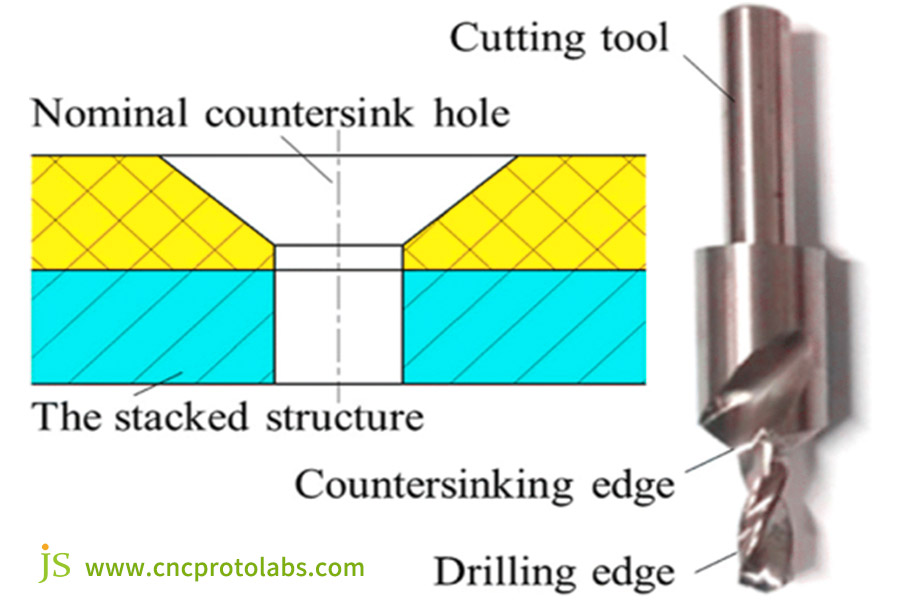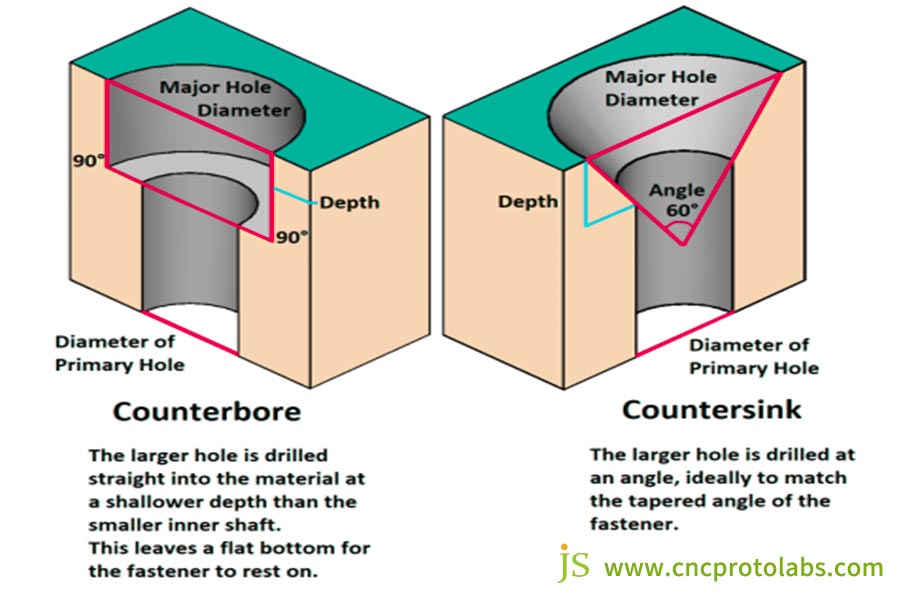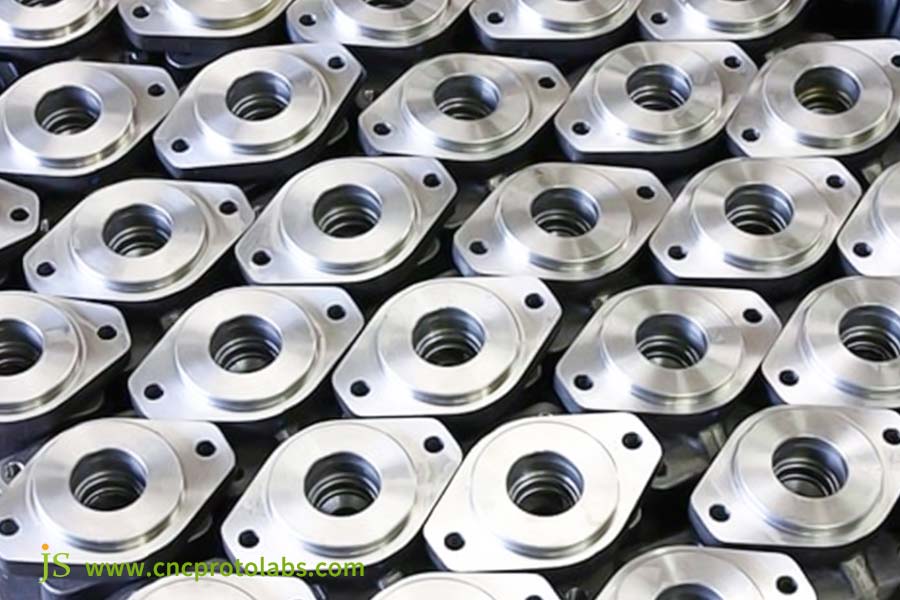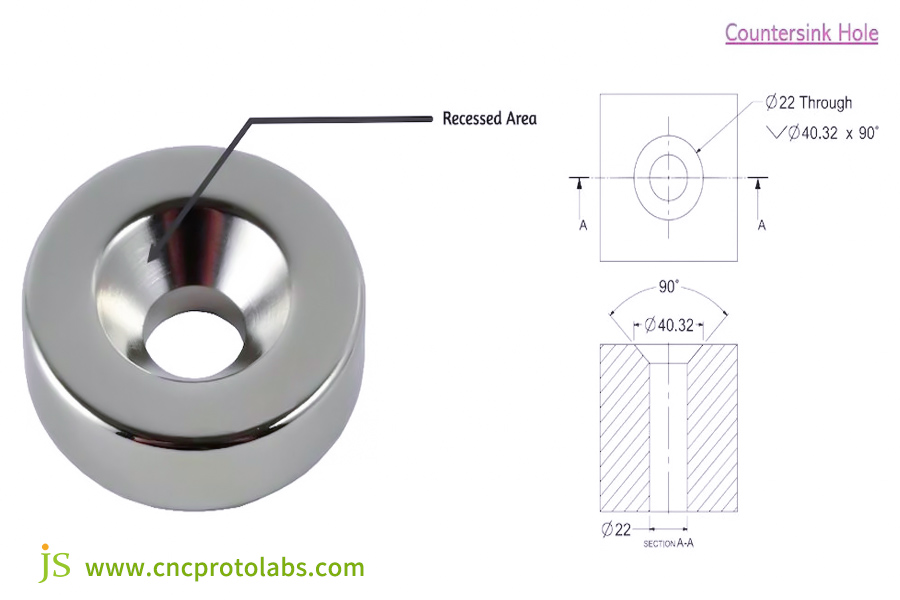In precision engineering and product design,details determine success or failure.A protruding screw head not only affects aesthetics,but may also cause functional impairment or safety hazards.Countersink Holes are an elegant solution to this problem.
For engineers and designers,understanding the application,advantages,technical details,and manufacturing processes of countersink not only enables them to determine whether it is the best choice for a project,but also significantly improves the quality of the final product while reducing manufacturing costs.
This ultimate guide will answer all your questions about Countersink Holes and demonstrate how to turn perfect designs into reality through professional CNC machining services.
Summary Of Core Answers
| Category | Content Summary |
| Define | a tapered inlet hole on the outer edge(⌵)to make the fastener head flush with the surface,which can remove burrs and reinforce the joint |
| Advantages | neat appearance,hidden fasteners,reduced risk,and improved load distribution |
| Difference from counterbore | Cone vs Cylinder;Using ⌵ vs ⌴ ;Adapt to different fasteners,countersink has low cost and is suitable for small screws, while countersunk is suitable for heavy loads |
| Common angles | include 82°(imperial),90°(metric),and 100°(BA screw) |
| Tools and service | countersink drills bit for processing ,CNC machining |
Why Trust This JS Guide?
Precise countersink is crucial for creating smooth surfaces and secure connections.At JS,we use advanced CNC machines to create perfect countersinks with tolerances as small as 0.02 millimeters for various industries.
Our aerospace clients trust us,and we are able to meet industry standards with a compliance rate of 99.5%.Our automotive customers appreciate our exquisite craftsmanship in producing holes with smooth and clean edges.Medical device manufacturers trust our PVD coated hard alloy cutting tools to ensure excellent surface quality for titanium alloy components.
Trust JS because our team has extensive industry service experience,ensuring strict tolerances,optimal surface treatment,and efficient production-even the most complex hole shapes can meet your needs.
Do not compromise on key features,such as countersinks that affect appearance and functionality.Contact us immediately to learn how our customized CNC machining services can solve your manufacturing challenges.
What Exactly Is A Countersink Hole?Why Use Countersink Holes?
Definition of Countersink
Countersink refers to a hole whose outer edge is opened into a conical inlet.Its symbol is ⌵.
Using countersink can make the head of fasteners such as countersunk bolts,screws,or rivets flush or lower than the surface of the surrounding material when inserted into the hole,making the fasteners invisible and achieving aesthetic purposes.The size of the countersink is usually determined based on the head size of the installed fastener.
Countersink can also remove residual burrs after drilling or tapping,improve surface smoothness,and remove any potentially dangerous sharp edges.
Countersink is suitable for woodworking and processing of softer materials.They can be used to reinforce joints or enhance the contact between screws and materials.
When processing wood,if the countersink is not directly inserted into the surface,it will not only affect the appearance of the wood,but also reduce its stability.Even worse,the wood may break or crack,and the fibers may also be damaged or dented.
The Importance of Countersink in Engineering
Countersink is indispensable in the fields of engineering and construction.Countersink can provide a smooth and flat surface,prevent fasteners from protruding and obstructing operations,causing danger or uneven surfaces,and improve joint strength and secure fasteners.
Here are some situations where countersink should be used:
- Reduce screw movement: Countersink processing can guide the screw head to the correct position,ensuring that the screw reaches the desired position.In addition,countersink processing can help you intuitively understand the position of screws in advance.
- Conical fasteners: Firstly,if you use tapered fasteners,you will need a countersink.In addition,a good alignment between the fastener head and the workpiece surface usually results in a good surface effect.
- Countersunk rivets: When connecting materials with rivets,filling the holes with the rivet might ensure that the rivet head is level with the surface of the material,thereby ensuring a smooth and non-jointed surface.
- Closing work: Countersunking finds extensive use in closing work where aesthetics is involved,i.e.,furniture making,cabinet making,or do-it-yourself.It could give the finished product a clean,shiny look.
- Mechanical parts: Countersinks in machinery or mechanical components avoid screw head sticking and ensure smooth operation of moving parts or mechanisms.
- Stop cracking: Countersink also helps prevent cracking or splitting into fragments when screwing screws along the material's edge.
- Reduce surface protrusions: Countersinking screws are able to obtain a smooth surface and prevent any protrusions or surface defects resulting from fasteners when assembling laminated or veneer materials.
Advantages of Countersink
- Neat and clean appearances
Countersink shape allows for flat head screws and other fasteners to be at or below the surface level,resulting in a neat and professional appearance.It is particularly useful in areas of use where aesthetics is a factor,such as furniture and household electronics.
- Hidden fasteners
It is also possible to hide fasteners with countersink,thus making them more aesthetically pleasing.For example,in woodworking,screws may be countersunk with putty and covered with paint to make them invisible.
- Prevent the risk of damage or injury
By countering the fasteners,countersink can prevent screw heads from being visible,lessening the possibility of damage or injury due to exposed screws.This applies especially in equipment or machinery,as visible screws may snag on clothing or cause injury.
- Minimize stress and enable load balancing
Facilitate countersink allows the weight of fasteners to be distributed more evenly across the whole surface.This reduces stress concentration and cracking or failure.A straight hole,however,localizes the stress at the screw head,leading to greater possibilities of damage over time.
If you pursue precision,durability,and stylish aesthetics in product design,countersunk holes are essential.When you have any custom countersink needs,please contact JS and we won't let you down.

The Critical Difference:Countersink And Counterbore
Both Countersink and Counterbore are suitable for almost the same type of fastener and do the same job-for technical or appearance purposes,to create a flush(or below flush)surface finish on the fastener.Nonetheless,there exist some differences between them.Some of those differences are presented below:
Shape
Countersink is a conical hole.And counterbore refers to a cylindrical flat bottomed hole utilized to accommodate hex screws or hex head screws.That is,countersink is conical,whereas counterbore is cylindrical.
Annotation symbol
Generally speaking,the annotation symbol of countersink is"⌵",and the annotation symbol of counterbore is"⌴a"as well.After the countersink or counterbore has been completed,these symbols are used to indicate the cross-sectional shape of various patterns of holes.
Fastener type
The countersink or counterbore quality determines the type of fastener.Standard head F-shaped fasteners are typically countersink,while counterbore fasteners are flat bottomed.
Size
Countersink is used with wood screws and metal screws,while counterbore is used with larger fasteners such as square head bolts.Directional drill bits are used by countersink and counterbore to determine the size of the respective holes.
Countersink requires a smaller guide drill bit than counterbore to accommodate small screws.Counterboring is used to create flat bottom holes for tighter fastening of metal screws and lock washers.Countersink and counterbore sizes are normally expressed in terms of diameter,depth,and counterbore angle.
The diameter is the width of the counterbore or countersink,and the depth is the distance from the surface of the material being drilled to the top of the guide hole.The counterbore size is usually 3/16 inch to 1 inch,but the minimum counterbore size can reach 1/16 inch and the maximum can reach 1/2 inch.
Drilling angle
Countersink can be made using drill bits of various sizes and drilling angles for different purposes.The commonly used angles include 120°,110°,100°,90°,82°,and 60°.But the most commonly used drilling angles are 82°and 90°.
To achieve optimal results,the angle of the countersink must match the cone angle at the bottom of the fastener head.The sides of the countersink are parallel,so there is no need for any taper.
Cost
The manufacturing process and materials used will affect the prices of countersinks and counterbores.Due to simpler manufacturing processes and cheaper materials,countersinks are usually cheaper than counterbores.Countersunk drills may require additional processes such as drilling and tapping,as well as more precise machining,thereby increasing the overall cost.
Usage
Countersink is typically used in situations where fasteners need to be hidden for aesthetic or tamper proof reasons.However,countersinks are typically used in situations where the material is too thin to perform countersinks.
Application
It should be noted that the design purpose of the counterbore is to form a flat bottomed hole for securely tightening metal screws and locking washers.Therefore,counterbore is commonly used for heavy-duty applications such as equipment and automobiles.
The following table compares the differences between Countersink and Courterbore:
| Features | Countersink | Courterbore |
|
Definition |
Cone shaped hole, allowing the screw to be flush with or below the surface | Flat bottomed hole, leaving space for bolts or screw heads |
| Shape | Conical(angled) | Cylindrical(flat bottomed) |
|
Annotation symbol |
⌵ | ⌴ |
| Drillingangle | usually 82°,90°,100°,or 120° | No angle,just a straight hole with a flat bottom |
| Fastener type | Paired with standard head F-shaped fasteners, usually of the countersunk type | Paired with flat bottomed countersunk fasteners |
| Size | -Used for wood screws and metal screws -Need a guide drill bit smaller than the countersunk hole -Dimensions are represented by diameter, depth, and angle -No specific scope mentioned |
-Used for larger fasteners such as square head bolts -Need a larger directional drill bit -Dimensions are represented by diameter, depth, and angle -Usually ranging from 3/16 inch to 1 inch, with a minimum of 1/16 inch and a maximum of 1/2 inch |
| Cost | Usually cheaper due to simpler manufacturing processes and lower material costs | Usually more expensive as it may require additional processes such as drilling and tapping, as well as more precise machining |
| Usage | Used in situations where hidden fasteners are required for aesthetic or tamper proof purposes | Used for situations where the material is too thin to make countersunk holes, it can form flat bottomed holes to tighten metal screws and locking washers |
| Application | Used in woodworking, printed circuit boards (PCBs), metal plates, plastics and other fields | Used in woodworking, printed circuit boards (PCBs) and other fields, especially suitable for heavy-duty applications such as equipment, construction, etc |
Countersink and counterbore are suitable for almost the same type of fastener and have the same purpose.It is crucial to utilize their key differences in order to select the most suitable hole type for the project.JS can provide assistance in this regard.

How To Countersink?
Common Countersink Angles(82°,90°,100°)
Countersink can be processed into six typical angles,including 60°,82°,90°,100°,110°,or 120°,depending on the application and fastener type.The following are common countersink angles and their applications in different industries.
- 82°British countersunk head screw(American standard)
In the United States,an angle of 82°is the standard angle for British countersunk screws.It is widely used in industries such as metalworking and woodworking that require screws to be flush.This angle allows the flat head screw to fit tightly,ensuring a firm and neat appearance.
- 90°suitable for metric countersunk screws
For metric fasteners,the standard countersunk angle is 90°.This is common in the international manufacturing industry,used for projects that require precise coordination,especially in the fields of electronics and automotive applications.It ensures consistency across different regions and industries.
- 100°angle suitable for BA screws
100°angle is suitable for British Association(BA)screws.These types of screws are commonly used in old-fashioned machinery and precision equipment.A larger angle helps provide a larger contact area,ensuring more effective fixation of precision or small components.
How to Specify Countersinks on a Drawing(The Callout)
When specifying countersink in the engineering drawing,clear and measurable details need to be provided.Firstly,match the dimensions of the drawing with the actual parts.Be sure to label the diameter and angle of the countersink and refer to the reference standard to ensure consistency.
Use hole annotations to display dimensions and angles,so that mechanics can accurately understand the content to be created.
1.List key dimensions such as diameter,angle,and depth.
2.Add tolerances(e.g.±0.2 millimeters)to define acceptable variations.
3.Use the countersink(CSK)symbol or abbreviation in annotations.
4.If precise control of position or alignment is required,apply GD&T tolerances.
5.Reference standards such as ISO 2768 or ASME Y14.5 are used for dimensioning practice.
The following is an example of the correct countersink annotation:
Ø10.0↧1.5-82°
This annotation specifies a countersink with a diameter of 10 millimeters,a depth of 1.5 millimeters,and an angle of 82 degrees.By clearly specifying these features,you can improve manufacturing accuracy and reduce errors.This method can also help you balance accuracy and cost,as stricter tolerances will increase processing time.
Always use standard dimensioning methods to avoid redundant details.By following these practices,your drawings can accurately convey the information required for high-quality countersinks.
Tools for the Job:How Countersinks are Machined
Special tools are required for countersink machining, such as countersink drills and deburring tools.Other important tools are also explained as follows:
- Buried drill bit
It is a conical tool used to form a conical surface at the top of a hole so as to be flush with the screw head.Common types of drill bits include groove countersunk drill bits,cross hole countersunk drill bits,and single or multiple groove countersunk drill bits - Bit
Drill bit is an electric tool used to fix and rotate countersunk drill bits.It can be manual or electric. - Screw
The type of screw(such as countersunk screw or flat head screw)will determine the angle of the countersunk screw. - Instrument
Depth gauge is used to measure the correct depth or tape measure is used to mark the position and size of holes - Clamp
Fixing metal during drilling process - Central Charge
Mark the starting point - Straight edge
Correctly align the countersink design.
Customized CNC machining of complex countersink
Unlike manual methods,custom CNC machining can simplify complex designs and create parts with perfect angles.Customized CNC machining of countersinks can achieve precise dimensions,which is particularly useful when using complex fasteners.
In addition,CNC machining provides greater flexibility in the size,depth,and angle of holes.CNC machining is the perfect solution for complex countersinks as it is completed in one go.Once the design is completed,you can easily mass process it.By using CNC drilling,almost no waste is generated,thereby minimizing the overall cost of the production process.
For high-precision manufacturing,CNC precision machining is an excellent choice.JS's machining factory provides five axis CNC machining,wire cutting,CNC milling,and other hole machining services to help your project succeed.
Case Study:Improving An Electronics Enclosure
Customer Requirements:
An entrepreneurial company must produce a set of aluminum alloy shell casings for its high-end audio decoder,with plain appearance and smooth touch.
Design challenge:The top cover and bottom plate of the casing are fixed in place by a number of M3 flat head screws,and exposure of the screw head will demolish the entire appearance and price of the product.
JS's Solution:
The center applies countersink technology in solving the problem of exposed heads of screws and improving the aluminum alloy shell.Determine the angle based on M3 flat head screw type(imperial 82°,metric 90°),accurately calculate the hole depth and diameter such that the head of the screw will be flat or slightly below.
Custom CNC machining:Control cutting parameters to provide accuracy,and execute polishing and chamfering to machine edges.Additionally,countersinking drill bits in pairs are selected for stabilizing machining with the help of depth gauges and fixtures.The adaptive CNC tool path is designed in such a manner that it decreases the occurrence of burrs,thus minimizing subsequent exact machining.It not only optimizes efficiency,but also provides more accurate and smoother hole geometries.
Result:
This design also readily accomplishes the flat and even surface of the shell,with all M3 flat head screw heads perfectly hidden,completely avoiding bulge issues and meeting customers'pursuit of minimal appearance.The gentle touch and smooth feel of the well-processed surface of the shell and the countersink edge meet customers'pursuit of feeling.
The plan has been highly appreciated by the client and laid a good foundation for future cooperation.
From the initial prototype stage to comprehensive manufacturing,JS provides one-stop custom CNC machining manufacturing,allowing you to transform digital designs into high-quality parts.In addition,our transparent and efficient online CNC machining services platform makes your custom CNC machining manufacturing experience more efficient and transparent.

FAQs
Q1:Why is Countersink so important?
For functionality(flat surface,no interference)and aesthetics(professional,smooth appearance),it directly affects the final quality and user experience of the product.
Q2:Are Countersink and Counterbore interchangeable?
Absolutely not.They are applied to screws of different head profiles.Misuse leads to reduced torque and part damage.
Q3:What if I'm unsure of what angle to use?
The rule is simple:use 90°for metric and 82°for imperial screws.If unsure,please don't hesitate to call our engineers whenever you wish.
Q4:What does your online quotation system do with countersinks?
Our system will automatically recognize the conical hole features in your CAD model and utilize them as countersinks for quotation purposes,so the whole process can be completed quickly and precisely.
Summary
Countersink is a critical component in engineering and manufacturing as it enables fasteners to be flush or below the surface,enhancing aesthetics and functionality.As mentioned above,the production of countersink may be extremely difficult.You can experience design issues affecting project pace and leading to delay in delivery.That is where we come in.
We are manufacturers specialized in turning your design better and offloading on you the complex countersink process.To know more about hole machining,kindly contact JS.JS offers diverse manufacturing services to satisfy your prototype production and design requirements,such as CNC machining,sheet metal manufacturing,etc.Learn more information or get a free quote by visiting our website.
Disclaimer
The contents of this page are for informational purposes only.JS seriesThere are no representations or warranties, express or implied, as to the accuracy, completeness or validity of the information. It should not be inferred that a third-party supplier or manufacturer will provide performance parameters, geometric tolerances, specific design characteristics, material quality and type or workmanship through the Longsheng Network. It's the buyer's responsibilityRequire parts quotationIdentify specific requirements for these sections.Please contact us for more information.
JS Team
JS is an industry-leading companyFocus on custom manufacturing solutions. We have over 20 years of experience with over 5,000 customers, and we focus on high precisionCNC machining,Sheet metal manufacturing,3D printing,Injection molding,Metal stamping,and other one-stop manufacturing services.
Our factory is equipped with over 100 state-of-the-art 5-axis machining centers, ISO 9001:2015 certified. We provide fast, efficient and high-quality manufacturing solutions to customers in more than 150 countries around the world. Whether it is small volume production or large-scale customization, we can meet your needs with the fastest delivery within 24 hours. chooseJS TechnologyThis means selection efficiency, quality and professionalism.
To learn more, visit our website:www.cncprotolabs.com








